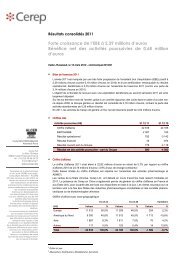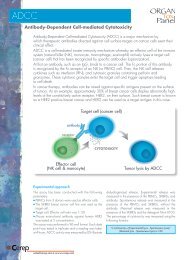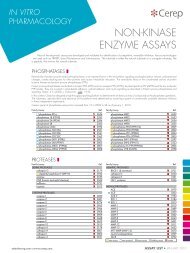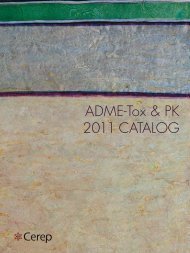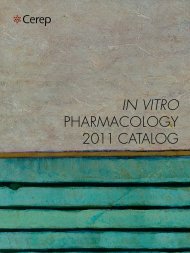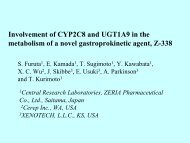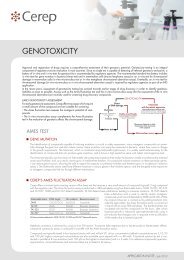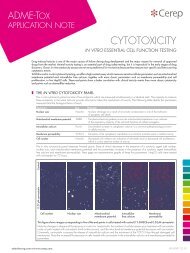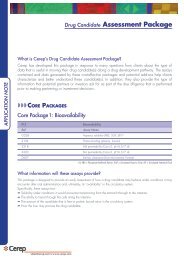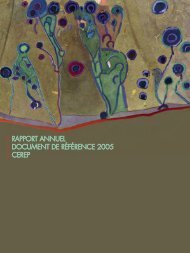in vitro PHARMACOLOGY 2011 CATALOG - Cerep
in vitro PHARMACOLOGY 2011 CATALOG - Cerep
in vitro PHARMACOLOGY 2011 CATALOG - Cerep
You also want an ePaper? Increase the reach of your titles
YUMPU automatically turns print PDFs into web optimized ePapers that Google loves.
107<br />
<strong>Cerep</strong><br />
services<br />
K<strong>in</strong>ases<br />
Receptors<br />
<strong>Cerep</strong>’s panel of k<strong>in</strong>ases has <strong>in</strong>creased from 205 biochemical assays as of January,1, 2009 to 271 (<strong>in</strong>clud<strong>in</strong>g 16 cellular k<strong>in</strong>ase assays)<br />
as of January 1, <strong>2011</strong> allow<strong>in</strong>g to provide a wider coverage of all major families <strong>in</strong> the human k<strong>in</strong>ome (Mann<strong>in</strong>g G. et al. (2002)<br />
Science, 298: 1912-1934).<br />
K<strong>in</strong>ases sub-families 1 P.<br />
Prote<strong>in</strong>-tyros<strong>in</strong>e k<strong>in</strong>ases 108<br />
RTK Receptor Tyros<strong>in</strong>e K<strong>in</strong>ases 108<br />
CTK Cytoplasmic Tyros<strong>in</strong>e K<strong>in</strong>ases 118<br />
Prote<strong>in</strong>-ser<strong>in</strong>e/threon<strong>in</strong>e k<strong>in</strong>ases 124<br />
CMGC Cycl<strong>in</strong>-dependent-(CDK), Mitogen-activated-(MAPK), Glycogen-synthase-(GSK) and CDK-like k<strong>in</strong>ases 124<br />
CaMK Ca 2+ /calmodul<strong>in</strong>-dependent prote<strong>in</strong> k<strong>in</strong>ases 130<br />
AGC prote<strong>in</strong> k<strong>in</strong>ases A, G and C cyclic nucleotide regulated and phospholipid-regulated k<strong>in</strong>ases and ribosomal S6 k<strong>in</strong>ases 137<br />
CK1 Case<strong>in</strong> K<strong>in</strong>ases 1 144<br />
STE homologs of yeast sterile k<strong>in</strong>ases 144<br />
TKL Tyros<strong>in</strong>e K<strong>in</strong>ase-Like 149<br />
other k<strong>in</strong>ases 151<br />
atypical k<strong>in</strong>ases 156<br />
1 Cohen P. (2002), Nature Reviews/Drug Discovery, 1: 309-315<br />
<strong>Cerep</strong> k<strong>in</strong>ase assays<br />
Ion<br />
channels<br />
Transporters<br />
<br />
K<strong>in</strong>ases<br />
Epigenetic &<br />
DNA-related<br />
enzymes<br />
❚ Biochemical k<strong>in</strong>ase assays<br />
Majority of our biochemical k<strong>in</strong>ase assays use activated k<strong>in</strong>ases. They are usually full length k<strong>in</strong>ase or cytoplasmic doma<strong>in</strong> of RTK. Assays<br />
are designed to be as close as possible to ATP and substrate Km.<br />
The technology used to measure substrate phosphorylation is TR-FRET (HTRF ® or LANCE ® ). A few assays are cascade of activation.<br />
NOTE: A majority of our k<strong>in</strong>ase assays have been converted from HTRF ® to LANCEUltra ® technology. Both technologies are TR-FRET<br />
with the difference <strong>in</strong> europium labell<strong>in</strong>g: europium cryptate for HTRF ® and europium chelate for LANCEUltra ® .<br />
Assays are converted follow<strong>in</strong>g a standard procedure consist<strong>in</strong>g of Time course experiment, Km determ<strong>in</strong>ation and pharmacology<br />
characterization of the enzyme by <strong>in</strong>hibit<strong>in</strong>g its activity with known <strong>in</strong>hibitors. IC 50 values obta<strong>in</strong>ed for known <strong>in</strong>hibitors are compared<br />
to literature and to those obta<strong>in</strong>ed us<strong>in</strong>g HTRF ® technology. If all values are <strong>in</strong> agreement with the previous ones, LANCE ® technology<br />
is validated for the k<strong>in</strong>ase of <strong>in</strong>terest. This conversion allows us to standardize and automate our k<strong>in</strong>ase assays provid<strong>in</strong>g shorter<br />
turnaround times for both profil<strong>in</strong>g and screen<strong>in</strong>g experiments.<br />
❚ cellular K<strong>in</strong>ase assays<br />
In order to complement our exist<strong>in</strong>g biochemical assay platform, we have implemented cellular k<strong>in</strong>ase assays. These assays allow to<br />
confirm <strong>in</strong>hibitors activity <strong>in</strong> a relevant cellular background and profile their selectivity aga<strong>in</strong>st multiple signal<strong>in</strong>g pathways.<br />
- Cellular k<strong>in</strong>ase phosphorylation assays<br />
Cellular k<strong>in</strong>ase phosphorylation assays are developed us<strong>in</strong>g AlphaScreen ® Surefire ® assay kits. The assays are optimized for directly<br />
measur<strong>in</strong>g k<strong>in</strong>ase activation follow<strong>in</strong>g treatment of cells with activators of signal<strong>in</strong>g pathways.<br />
- Cellular tyros<strong>in</strong>e k<strong>in</strong>ase receptor activity assays<br />
We have demonstrated that the impedance-based technology can be used to monitor the activity of the ma<strong>in</strong> tyros<strong>in</strong>e k<strong>in</strong>ase receptor<br />
families. These label-free assays allow the identification of <strong>in</strong>hibitors target<strong>in</strong>g either the ligand b<strong>in</strong>d<strong>in</strong>g doma<strong>in</strong> or the k<strong>in</strong>ase doma<strong>in</strong>.<br />
These assays can be developed <strong>in</strong> virtually any cancer cell l<strong>in</strong>es or primary cells. As an example, we have developed and validated<br />
the EGFR cellular assay <strong>in</strong> the follow<strong>in</strong>g cancer cell l<strong>in</strong>es: A431, HELA and MDA-MB-231.<br />
❚ b<strong>in</strong>d<strong>in</strong>g K<strong>in</strong>ase assays<br />
To expand our exist<strong>in</strong>g k<strong>in</strong>ase services, we offer b<strong>in</strong>d<strong>in</strong>g k<strong>in</strong>ase assays to identify type II <strong>in</strong>hibitors on unphosphorylated k<strong>in</strong>ases, to<br />
compare compounds activity on unphosphorylated and phophorylated k<strong>in</strong>ases and to discrim<strong>in</strong>ate between ATP and non-ATP competitive<br />
<strong>in</strong>hibitors. In addition, we are now us<strong>in</strong>g ADP readout to develop k<strong>in</strong>ase assays on <strong>in</strong>tractable substrates (for which no antibody exist)<br />
which allows us to profile k<strong>in</strong>ase activity on different natural substrates <strong>in</strong> order to identify substrate selective <strong>in</strong>hibitors. These assays are<br />
displayed as part of our custom research.<br />
For further <strong>in</strong>formation, please contact us at customresearch@cerep.com.<br />
Other<br />
enzymes<br />
Specialized<br />
cellular<br />
assays<br />
Standard<br />
profiles<br />
Test<strong>in</strong>g<br />
conditions<br />
Order<strong>in</strong>g<br />
<strong>in</strong>formation<br />
Assay list<br />
& <strong>in</strong>dex



